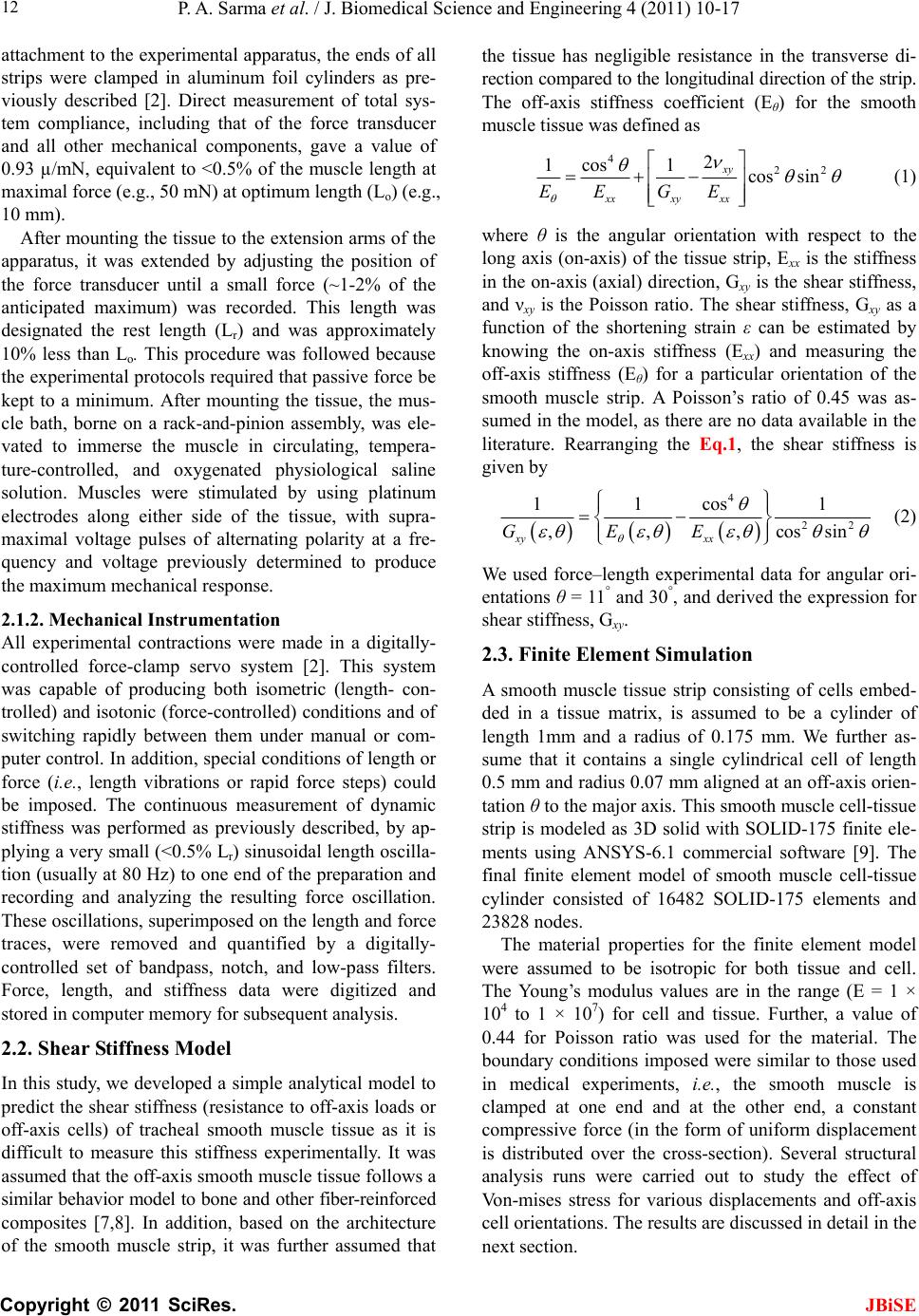
P. A. Sarma et al. / J. Biomedical Science and Engineering 4 (2011) 10-17
Copyright © 2011 SciRes. JBiSE
12
attachment to the experimental apparatus, the ends of all
strips were clamped in aluminum foil cylinders as pre-
viously described [2]. Direct measurement of total sys-
tem compliance, including that of the force transducer
and all other mechanical components, gave a value of
0.93 µ/mN, equivalent to <0.5% of the muscle length at
maximal force (e.g., 50 mN) at optimum length (Lo) (e.g.,
10 mm).
After mounting the tissue to the extension arms of the
apparatus, it was extended by adjusting the position of
the force transducer until a small force (~1-2% of the
anticipated maximum) was recorded. This length was
designated the rest length (Lr) and was approximately
10% less than Lo. This procedure was followed because
the experimental protocols required that passive force be
kept to a minimum. After mounting the tissue, the mus-
cle bath, borne on a rack-and-pinion assembly, was ele-
vated to immerse the muscle in circulating, tempera-
ture-controlled, and oxygenated physiological saline
solution. Muscles were stimulated by using platinum
electrodes along either side of the tissue, with supra-
maximal voltage pulses of alternating polarity at a fre-
quency and voltage previously determined to produce
the maximum mechanical response.
2.1.2. Mechanical Instrumentation
All experimental contractions were made in a digitally-
controlled force-clamp servo system [2]. This system
was capable of producing both isometric (length- con-
trolled) and isotonic (force-controlled) conditions and of
switching rapidly between them under manual or com-
puter control. In addition, special conditions of length or
force (i.e., length vibrations or rapid force steps) could
be imposed. The continuous measurement of dynamic
stiffness was performed as previously described, by ap-
plying a very small (<0.5% Lr) sinusoidal length oscilla-
tion (usually at 80 Hz) to one end of the preparation and
recording and analyzing the resulting force oscillation.
These oscillations, superimposed on the length and force
traces, were removed and quantified by a digitally-
controlled set of bandpass, notch, and low-pass filters.
Force, length, and stiffness data were digitized and
stored in computer memory for subsequent analysis.
2.2. Shear Stiffness Model
In this study, we developed a simple analytical model to
predict the shear stiffness (resistance to off-axis loads or
off-axis cells) of tracheal smooth muscle tissue as it is
difficult to measure this stiffness experimentally. It was
assumed that the off-axis smooth muscle tissue follows a
similar behavior model to bone and other fiber-reinforced
composites [7,8]. In addition, based on the architecture
of the smooth muscle strip, it was further assumed that
the tissue has negligible resistance in the transverse di-
rection compared to the longitudinal direction of the strip.
The off-axis stiffness coefficient (Eθ) for the smooth
muscle tissue was defined as
4
22
2
1cos 1cos sin
xy
xxxy xx
EE GE
(1)
where θ is the angular orientation with respect to the
long axis (on-axis) of the tissue strip, Exx is the stiffness
in the on-axis (axial) direction, Gxy is the shear stiffness,
and νxy is the Poisson ratio. The shear stiffness, Gxy as a
function of the shortening strain ε can be estimated by
knowing the on-axis stiffness (Exx) and measuring the
off-axis stiffness (Eθ) for a particular orientation of the
smooth muscle strip. A Poisson’s ratio of 0.45 was as-
sumed in the model, as there are no data available in the
literature. Rearranging the Eq.1, the shear stiffness is
given by
4
22
11cos1
,,,
cos sin
xy xx
GEE
(2)
We used force–length experimental data for angular ori-
entations θ = 11° and 30°, and derived the expression for
shear stiffness, Gxy.
2.3. Finite Element Simulation
A smooth muscle tissue strip consisting of cells embed-
ded in a tissue matrix, is assumed to be a cylinder of
length 1mm and a radius of 0.175 mm. We further as-
sume that it contains a single cylindrical cell of length
0.5 mm and radius 0.07 mm aligned at an off-axis orien-
tation θ to the major axis. This smooth muscle cell-tissue
strip is modeled as 3D solid with SOLID-175 finite ele-
ments using ANSYS-6.1 commercial software [9]. The
final finite element model of smooth muscle cell-tissue
cylinder consisted of 16482 SOLID-175 elements and
23828 nodes.
The material properties for the finite element model
were assumed to be isotropic for both tissue and cell.
The Young’s modulus values are in the range (E = 1 ×
104 to 1 × 107) for cell and tissue. Further, a value of
0.44 for Poisson ratio was used for the material. The
boundary conditions imposed were similar to those used
in medical experiments, i.e., the smooth muscle is
clamped at one end and at the other end, a constant
compressive force (in the form of uniform displacement
is distributed over the cross-section). Several structural
analysis runs were carried out to study the effect of
Von-mises stress for various displacements and off-axis
cell orientations. The results are discussed in detail in the
next section.